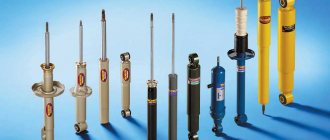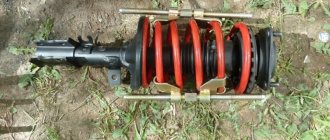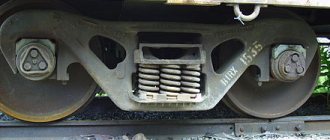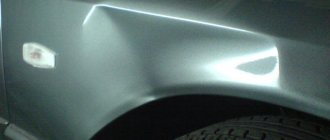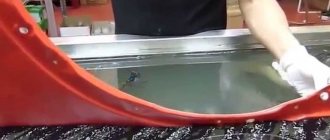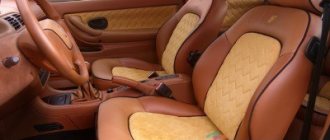Shock absorber
Shock absorber
(from the French amortisseur) - a device for damping vibrations (
damping
) and absorbing shocks and impacts of moving elements (suspension, wheels), as well as the body of the vehicle itself, by converting the mechanical energy of movement (oscillations) into heat.
Shock absorbers are used in conjunction with elastic elements—springs or leaf springs, torsion bars, pillows, etc.—to dampen free vibrations of large masses and prevent high relative velocities of smaller masses connected by elastic elements.
Do not confuse the outwardly similar hydraulic tube shock absorber and gas spring. The latter are also often found in automotive equipment and everyday life, but have a different purpose (namely, to create a pushing force on the rod, for example, to hold the hood or trunk lid of a car open).
Briefly about the modern shock absorber market
The annual Russian Auto Component of the Year award allows us to identify the most successful brands in each category. Thus, in 2016, the leading Russian shock absorber brand was DEMFI, which presented budget-class struts and shock absorbers of the Comfort series of improved quality Premium and Drive. The company's products include front and rear shock absorbers for VAZ, IZH, Lada, Ford Focus2, Renault Logan. Today DEMFI is a small enterprise (less than 60 people work there), but high-tech and knowledge-intensive, capable of expanding production subject to adequate demand.
The shock absorbers of the UAZ “Hunter” from the St. Petersburg company “Plaza” also deserve high praise. They are available in three modifications: “standard”, “sport” and “extreme”. Among foreign brands, the first and fourth places were won by the brands Monroe (USA/Belgium), TRW (Germany), KYB (Japan) and EGT (Lithuania), respectively.
How can a beginner amateur figure out which shock absorbers are better? After all, the world's leading manufacturers are demonstrating increasingly sophisticated developments of international class. For example, only Monroe today enters the market with various brands of shock absorbers: Reflex, Sensa-Track, Original, Advanced, and Van Magnum. They are the ones who currently dominate the modern car market. A sign of the high reputation of the Monroe company is that it is equipped with shock absorbers recreated directly on the assembly line of Ford, Nissan, Renault, Mitsubishi, Volvo, and Porsche cars.
The German auto industry uses mainly domestic shock absorbers. Reviews from car enthusiasts indicate that Opel, Mersedes, and Audi traditionally use products from the ZF concern (which owns the brands Sachs, Boge, TRW). The original Toyota, Mitsubishi shock absorber is a product of the Japanese company KYB (KAYABA brand). However, this brand is becoming more and more popular in both the New and Old Worlds. Currently, the following A series are imported: oil Premium, gas-oil Excel-G, gas Gas-A-Just, sports Ultra-SR, regulated AGX, off-road Monomax.
What shock absorbers does Hyundai (Korean company) install on its cars on the assembly line? It is logical that from another Korean company that produces auto components. Moreover (this is a feature of Korea) both companies are run by relatives. The manufacturer of shock absorbers under the MANDO brand is called Halla Group. Its factories operate in Korea, India, Turkey, China, Poland, and the USA. Tens of millions of dampers are manufactured every year. Ford, Peugeot, Nissan, BMW, Suzuki, Renault, GAZ install MANDO shock absorbers on their conveyors. It is significant that shock absorbers from KIA (another Korean auto corporation) are also supplied from Halla Group.
Brand competition
The competition between manufacturers is so significant that imported brands successfully compete with local ones. In particular, some drivers prefer Japanese cars to European ones. Thus, according to reviews from vehicle owners, the Renault gas-oil shock absorber produced by Kayaba is currently in great demand.
It is preferable for most current models of this brand: “Kengo”, “Megan”, “Traffic”, “Premium”, “Master”, “Clio”, “Laguna”, “Magnum”, etc. Its price is 30% higher higher than the cost of an oil device, but it is noticeably more effective when driving on rough roads. Therefore, drivers prefer the Renault gas-oil shock absorber to the cheaper oil shock absorber.
Note that Renault models intended for extreme driving on good roads are equipped with special shock absorbers - Kayaba Ultra SR. After all, high-speed cornering determines a large load on such products, both compression and rebound. However, for everyday city traffic they are not optimal, since they have increased rigidity, and for imperfect roads, as is known, softer springs are needed.
However, in this article we will not limit ourselves to a review of the shock absorber market. Our goal is broader - to reveal the secrets of their successful operation. As you know, shock absorbers are the supporting elements of the suspension; accordingly, let’s imagine an ideal suspension. As you know, this element performs two tasks:
- Firstly, it connects the car wheels to the body. Thanks to it, the wheel grip on the road necessary for full movement is ensured.
- Secondly, it neutralizes (absorbs) vibrations that arise during movement.
The main advantages and disadvantages of a monotube gas-filled shock absorber
Of course, there are certain shortcomings in the design of monotube gas-filled shock absorbers. The most noticeable problem here is that the production of shock absorbers of this type requires extreme precision, which, of course, is clearly reflected in their final cost. For example, to ensure adequate sealing of the rod, its surface cannot have a roughness of more than 0.1 microns. The second disadvantage of a single-tube gas-filled shock absorber is its length, which is significantly longer than that of twin-tube designs. Among other things, with a very thick piston rod and high displacements of the piston itself, the chamber filled with gas begins to play the role of a kind of additional spring - this leads to unfavorable effects that affect the quality of vehicle handling in a variety of driving modes.
Depreciation is...
Upon closer examination of the suspension elements, it becomes clear that shock absorbers are damping (vibration damping) devices. At the dawn of the automotive industry (XIX - early XX centuries), the mentioned parts did not exist at all. At low speeds of the first cars, springs alone were enough to balance the suspension. However, in the modern dynamic age of speeds, the suspension not only contains improved springs (leaf springs), which are now often called somewhat abstractly - an elastic element. This is no longer enough. To illustrate what has been said, consider a typical case of a car overcoming a bump in the road.
In this case, the task of the elastic element is obvious - when the wheels hit an uneven road, it must soften this blow. However, when a modern car moves, it has enormous kinetic energy, and the elastic element does not immediately cope with the “extraordinary emissions” of which on potholes in the road. Therefore, the inertia of the body causes the springs to oscillate even after a collision. This is a highly undesirable effect. After all, it can lead to resonance, which can lead to a car accident (remember physics and force vectors). This happens when the oscillation of a spring due to another unevenness in the road combines with its previous oscillation, which, alas, was not extinguished. Automotive engineers responded appropriately to this phenomenon by inventing a special damping device.
At the beginning of the 20th century, a damper (shock absorber) was created to dampen vibrations of the elastic element. The idea behind his work turned out to be quite simple and elegant. After the unevenness of the road causes the spring to compress, its subsequent expansion and, accordingly, vibration will be dampened by a special device - a shock absorber. However, we will not consider it as the only part that protects against vibrations, because for the ideal behavior of a car on the road, a shock absorber and an elastic element alone are not enough.
Not shock absorbers alone
The shock absorbers we mentioned above are special elements for maintaining the maximum possible horizontal and stable position of the suspension in space. But this is not enough for a truly efficient suspension. For maximum comfort for passengers and the driver, so that the car does not count bumps, but floats smoothly along the road, coordinated operation of shock absorbers and other devices is necessary, such as:
- tires made of excellent rubber, providing proper grip on the road;
- unworn springs and suspension springs (except for the functions we have already mentioned) must maintain the ground clearance specified in the technical specifications and keep the car at the same level;
- additional rubber-metal elements (hinges and compression buffers) that dampen vibrations from metal parts touching each other;
- guide devices that determine the desired angle of rotation of the wheels.
However, be that as it may, the main damping device of a car is the shock absorbers - the subject of this article. With their help, harmony is achieved in the constant contact of the wheels with the road surface (the car moves as if tied to the road), and, in principle, truly comfortable driving becomes possible.
Manufacturing materials
The seatpost should be strong, lightweight and durable. All these parameters depend on what material they are made of. The seat stem can be made from the following metals:
- Steel – pins made of steel alloys are now found only on old and very cheap bicycles. Such pins are the heaviest and short-lived; in addition, steel is a soft metal and can be easily deformed.
- Aluminum – Aluminum alloy is the most popular material for seat stems. It is popular because I use it to make pins of both the lowest and highest levels. Aluminum pins are strong, rigid, durable and lightweight.
- Carbon – Carbon fiber is mainly used to make stems for racing road bikes. The carbon seatpost is the lightest.
- Titanium is a good, but expensive material, so it is rarely used.
- Scandium - only the highest level pins are made from this material.
What does the shock absorber look like?
Externally, it looks like a cylindrical device attached on one side to the car frame and on the other to the suspension. A piston moves inside the shock absorber. This is a rod moving in a cavity filled with gas, oil or brake fluid. Due to the compression of the oil by the piston, its speed of movement decreases. The vibrations of the suspension are determined by the vibrations of the shock absorber piston. The more actively the suspension moves (which happens on rough roads), the more resistance the shock absorber exhibits. Various shocks received when driving a car on an uneven road, as well as vibrations during sudden braking or at the beginning of movement, are damped (softened) by a shock absorber. In this case, the kinetic energy of vibration is converted into thermal energy, obtained when the oil is compressed by the piston. The resulting heat is dissipated.
Internal bypass shock absorber
Where : Ford F-150 Raptor
In Ford twin-tube Fox shock absorbers, fluid flows through numerous bypass pipes. The working fluid bypasses the piston and flows through the holes into the inner cylinder, filling the area behind the piston. Some oil also passes through the piston shim stack and through the bottom valve during compression. The size, position and adjustment of the holes progressively increases the damping rate when the suspension is compressed or rebound. When the rod passes through the last bypass hole, the working fluid predominantly passes through the shim stack attached to the rod, which significantly increases the damping force. The bottom valve plays an important role during the entire compression stroke and regulates the flow of working fluid entering the external reservoir. This provides stable control of compression resistance and reduces cavitation (air pockets in the oil) when driving at high speed.
See also: You'll never guess why all those holes are needed in the new Honda Civic Type R
(Note on picture): “If you increase the spring rate before you drive the car, you can predict what will happen. With magnetorheological shock absorbers, even after many years, I am still learning a lot, still experimenting. I keep finding new things,” Mike Hurley, Chevrolet Performance Engineer. He has been debugging magnetorheological shock absorbers since they were introduced in the 2003 Cadillac XLR.
Depreciation process
How does a shock absorber react when a tire hits a pothole? It compresses, absorbing the impact, while its piston works in concert with the suspension springs. However, the operating cycle of the device does not end there, since it expands, i.e., the piston moves out of the shock absorber. Without it, the suspension springs would throw the car's body upward with the same force with which they were compressed when colliding with a pothole. However, the movement of the car's shock absorber piston, which works to expand, is also inhibited by oil.
Shock absorber design
Technically, the device, during its operation, converts mechanical vibrations of the elastic element into thermal ones. Replacing shock absorbers that have exhausted their effective service life is a responsible matter. After all, the person who installs the “new thing” immediately notices changes in the behavior of the car. Therefore, the correct selection of shock absorbers is critical for a knowledgeable driver. And believe me, there are plenty to choose from. The car market is saturated with relevant products from famous (branded) and not so famous manufacturers. We will return to cover this aspect later. But first, it would be logical to abstract from the principle of “whose will you be” and try to “look at the root”, that is, to understand the fundamental differences between different types of shock absorbers (A).
Judging by the design differences, A are divided into single- and double-pipe. If we classify according to the type of working substance that dissipates the heat obtained after the conversion of kinematic energy, then shock absorbers are oil, gas-oil and gas.
Application
In the automotive industry
The approach to the purpose of a shock absorber in various schools of automotive engineering can to some extent be determined by the name that is given to it. For example, German Dämpfer - vibration damper (damper), English. Shock-absorber - shock absorber.
In tank building
In tank building, the operating principle of German telescopic shock absorbers from the Second World War (Pz.III, Pz.V, Pz.VI tanks) and the friction shock absorber of the modern Leopard-2 does not provide for shock absorption. The first ones are single-acting during the reverse stroke of the roller, that is, if there is an impact during the forward stroke of the roller, they practically do not work; the resistance of the second does not depend on the speed of movement of the roller, therefore, upon impact, the shock absorber will absorb approximately the same amount of energy as when the roller moves slowly by the same amount . The British mainly used double-acting hydraulic shock absorbers (Crusider, Cromwell, Valentine tanks), the resistance of which depends on the speed of movement of the roller and increases many times upon impact, hence the name “shock absorber”.
In aircraft engineering
In aircraft engineering, powerful shock absorbers are used on aircraft landing gear. Their task (as well as the task of the entire chassis structure) is similar to shock absorbers in cars - to soften overloads upon contact with the runway surface during landing, so that the loads on the aircraft components do not exceed permissible values during a normal landing, and also so that in emergency cases make a safe landing for people when exceeding the maximum landing weight up to the maximum take-off weight.
Shock absorbers on the landing gear of almost all modern aircraft are built on the principle of a gas spring - the elastic element in such a shock absorber is not a mechanical spring, but technical nitrogen, charged (pumped into the shock absorber cavity) from a ground-based airfield nitrogen tanker, under a strictly defined pressure, depending on the take-off weight of the aircraft for a given flight and ambient temperature. Single-chamber, two- and even three-chamber shock absorbers are used.
By rail
In railway transport, energy must be dissipated in both the vertical, horizontal transverse, and horizontal longitudinal directions relative to the movement. Shock absorbers in the first two directions are usually oil-based and are installed at an angle of 45 degrees between the vertical and horizontal planes transverse to the movement. That is, one shock absorber absorbs energy in two directions. Longitudinal shock absorbers of railway rolling stock are called the draft gear of an automatic coupler. Draft gears are divided into cargo and passenger types. Load-type draft gears are distinguished by classes T0, T1, T2, T3 - depending on the energy it absorbs (50 kJ - the first and 190 kJ - the last) and its other technical characteristics described in OST-32-175-2001.
In shipbuilding
In shipbuilding, rubber-metal shock absorbers AKSS (welded ship shock absorbers with insurance) are used to protect equipment from vibration and shock loads. The AKSS shock absorber is a rubber-metal product consisting of a metal bracket, a carrier bar and a support bar, which are interconnected by a vulcanized rubber mass. To protect electrical panels and control panels from vibration and shock loads, cable shock absorbers are used in shipbuilding.
Double pipe products
What shock absorbers can be recommended for quiet, so-called family driving? Relatively inexpensive, simple in design, which cannot withstand extreme conditions. Double-pipe A are more inert and have more mass. In addition, the double case cools worse. At the same time, the damping efficiency of two-pipe devices depends on the correct installation. As you know, a shock absorber mounted strictly perpendicular to the suspension performs its functions 100%, but if this angle increases to 50°, then its effectiveness decreases to 68%.
The design of such elements includes a working flask, inside of which a piston is located, as well as an outer casing designed to store excess oil. During its working cycle, the piston passes some of the oil through its channels, and also squeezes it out through the compression valve located at the bottom of the bulb. When purchasing products, you should pay special attention to the oil, which should not boil at temperatures below 150 °C. At the same time, despite the favorable price, they should not be installed on the latest generation cars.
Design and functions of shock absorbers
For the convenience of traveling in horse-drawn carts, a spring was invented. But for cars, such a part was not enough, and the developers had to solve the problem of vertical vibrations. Shock absorbers, invented by designers, are still an essential tool to achieve a better balance between comfort and handling.
Attention! The hardness or softness of shock absorbers depends on the amount of oil (or other shock-absorbing fluid) passing through the holes per unit time.
The essence of the work of shock absorbers is to reduce the amplitude and amount of vibration of the springs. They act like regular oil pumps. The small cylinder is located in the large one. The oscillating suspension moves the rod. They drive a piston that compresses the oil in the cylinder. Oil is forced through microscopic holes into a larger second cylinder, slowing the piston and therefore the suspension.
Monotube shock absorbers
This design is basic for modern A. Such a shock absorber consists of a single flask, which simultaneously serves as both a working container for the piston and a housing. It can be hydraulic (oil) or hydropneumatic (gas-oil). The last modification is also called combined. The operating principle of oil A is quite simple. There is a working cylinder filled with oil (hydraulic fluid). It moves a piston with special calibrated valves, or rather with their system, which has characteristics specially selected for the suspension of a particular car model.
The operating dynamics of such a shock absorber are as follows:
- When the valves are closed, hydraulic fluid flows only through the bypass channel of the piston. The hydraulic characteristic of the shock absorber becomes rigid.
- If the valves adjacent to compensation chamber A open, then its hydraulic characteristic becomes softer.
Moreover, for the shock absorber to work properly, the valve operating on compression must allow more hydraulic fluid to pass through than a check valve operating on rebound. Thus, when the piston valves are open, the stiffness of the shock absorbers decreases.
Twin-tube shock absorbers
There are also other models on the market consisting of two or one cylindrical steel tubes with a rod moving up and down inside, which is attached to the frame or body of the car. The system includes calibrated valves that allow you to adjust the compression and rebound forces. They also control the passage of oil through them depending on the driving conditions. Twin-tube shock absorbers, as their name suggests, consist of two concentric tubes. These tubes form the working and reserve chambers.
In order for the shock absorber to function correctly, the working chamber must always be completely filled with oil, otherwise the valves will operate in an air environment, which will cause them to malfunction. The backup chamber is partially filled, because... it should ensure that the working chamber is filled with oil, regardless of the compression ratio of the shock absorber. Both tubes are separated, and the compression valve is located at the base of the working chamber.
Combined shock absorbers
In hydropneumatic (gas-oil) shock absorbers, compressed gas under a pressure of 4-20 atmospheres is used instead of air. Motorists call it in their own way - “gas boost”. Moreover, gas pressure is not a whim, but a way to reduce aeration (mixing air with oil), as well as an additional element of suspension elasticity. Mono-pipe A's do not have a bottom compression valve. The piston completely controls the resistance during both compression and rebound. They can accommodate more oil than two-pipe ones of the same volume, which means that with their help better damping is achievable.
Main malfunctions of shock absorbers
Which suspension elements are affected by faulty shock absorbers?
There are not so many malfunctions of shock absorbers, but all of them lead to the fact that these elements are replaced, since they are not repairable.
As for oil and gas-oil shock absorbers, the most common malfunction in them is depressurization, as a result of which some of the oil comes out. And due to a lack of oil, the overall performance is impaired; the shock absorber is no longer able to fully perform its function.
It is also possible that the rod may bend, causing it to jam in one of the positions.
Impact loads that cause dents in the body do not always have a significant effect on the performance of a twin-tube shock absorber. After all, there is a distance between it and the working cylinder, so a dent only leads to a decrease in the free space inside.
But in a monotube shock absorber, a dent on the body is fatal. It will block the ability of the piston and rod to move - the shock absorber will jam and stop working.
Also, in a monotube shock absorber, depressurization of the housing occurs, which leads to malfunction.
Controlled and magnetic shock absorbers
Leading shock absorber manufacturers are trying to solve the technical problem of adjustability of such devices in a rather original way. The American-Belgian company MONROE has made special adjustment grooves on the walls of the monopipe A working cylinder, used to adjust for quiet or active driving. The Japanese company KYA installed a separate control valve in the lower part of the single-pipe with remote reservoir A, bypassing the piston. The German concern ZF created its Opel Astra controlled shock absorber using a two-pipe gas-oil design. Two solenoid valves at the bottom of the shock absorber and in the piston are regulated by a special processor that monitors the parameters of the wheels, steering wheel, and suspension.
Even more promising is the new so-called Chevrolet magnetic shock absorber, installed last year on the Chevrolet Corvette. This is a joint promising development of the automaker and the Delphi corporation. The magnetorheological fluid used in them instead of oil is capable of changing its viscosity at high frequencies (up to 1000 times per second) under the influence of an electromagnetic field. In this case, the valve system is not used in principle: damping is carried out exclusively due to the magnetorheological effect. This design is very promising: there is no need for transverse stabilizers, the design of the A itself is simplified, and there are also impressive possibilities for monitoring and controlling the stiffness of the suspension.
Magnetorheological shock absorbers
Where : Cadillac CTS-V, Chevrolet Corvette, Ferrari 488GTB, Lamborghini Huracan
Magnetorheological shock absorbers do not have valves responsible for the damping coefficient. The movements of the wheels and car body are controlled by changing the viscosity of the oil. And although the design of shock absorbers is relatively standard (a rod at the end of a piston moves inside a cavity with hydraulic fluid), the principle of their operation is different. The new generation of magnetorheological shock absorbers uses two electromagnetic coils located in the piston. They are the ones that generate the local magnetic field. The hydraulic fluid inside the shock absorbers contains tiny ferromagnetic particles that are distributed randomly until electric current passes through the magnetic coils. The current passing through the magnetic coils creates a magnetic field that distributes the particles into rows. As the orientation of the magnetic particles changes, the viscosity of the liquid also changes. When the pressure exerted on either side of the piston is strong enough to break up these rows of particles, fluid flows through the passages, causing the piston to move. The force of particle alignment is proportional to the strength of the magnetic field, so changes in the current strength of the coils leads to a change in the damping force.
Correspondence of the hydraulic characteristics of the shock absorber to the road terrain
The design of the shock absorber must take into account various aspects of its operation. After all, poor-quality road surfaces determine different modes of its operation. On the one hand, repeated small irregularities do not allow A to straighten out. In this case, a soft hydraulic characteristic is relevant. Large potholes threaten complete forced compression of the shock absorber, which often causes damage to the shock absorber. At the same time, a rigid hydraulic characteristic of the device is in demand.
Therefore, it makes no sense to ask: “Which shock absorbers are better - soft or hard?” After all, not only their softness, but also controllability becomes relevant in terms of long-term operation.
Another characteristic - heat dissipation of the shock absorber - is important for its correct operation. Indeed, under harsh conditions, more heat is released, and it must be removed. On the other hand, in winter the oil in the shock absorber thickens and its hydraulic characteristics become more rigid. At the same time, the correct choice of oil becomes important for the car enthusiast. It is undesirable to use fluids with a high content of additives, because the latter tend to soften the rubber. Most often, experts recommend using branded oils GRZh-12, AFT. However, in cold weather you should choose a liquid with a viscosity of 75Wt. For oils containing silicone, the degree of viscosity is determined in other units - cPs, which are approximately 10 times greater than Wt.
Diagnostics of shock absorbers
Since nothing lasts forever, shock absorbers are also subject to wear. The driver should diagnose this phenomenon in time. As you know, replacement of shock absorbers that have lost their proper functionality should be done immediately upon detection. Moreover, the most effective is a comprehensive replacement of A: in pairs on each axle - both on the front and on the rear. After all, it is naive to expect ideal damping after incomplete replacement of shock absorbers.
However, this alone is also not enough. The entire complex of vehicle devices involved in damping should be diagnosed. After all, normal operation of shock absorbers is possible with serviceable rubber-metal elements (hinges and compression buffers), unworn springs and leaf springs. Maintaining all the above parts and mechanisms will reduce the load on the shock absorbers.
Types of seatposts with shock absorber
There are two models of shock absorber seatposts:
telescopic and parallelogram (lever)
. Both types require preload adjustment, which is equated to the weight of the cyclist.
Without adjustment, riding on an unadjusted seatpost will be uncomfortable and may cause damage to bicycle parts (frame). These seatposts are made mainly from aluminum alloy.
To understand what is their difference and what you should choose, you need to consider them in detail.
Telescopic shock-absorbing pins
Such models have a design that includes internal and external tubes sliding next to each other.
The internal mechanism contains an elastomer and an elastic solid spring. A wide variety of sizes can be purchased. The length can be 2.5 - 3.5 cm or 2.5 - 3.24 cm. In geometric terms, the travel of telescopic seatposts is from 3 to 6 cm. They weigh from 400 to 700 grams. This pin is adjustable to the required weight category.
Disadvantages of the device:
- high internal friction of the damping system leads to low sensitivity, which does not soften small bumps;
- When adjusting the height of the seat, it is necessary to take into account how much it will sag. Under prolonged heavy loads, the elastomers and springs are compressed, causing the seat to sag;
- heavy in weight.
Pros of the device:
- low cost;
- has a long service life;
- has a simple design.
Parallelogram shock-absorbing pins
Second name for parallelogram device
– lever. Its mechanism includes 2 levers, which are connected in parallel using hinges. A damping elastic elastomer is attached between them. When pushed, the elastomer is compressed, after which the seat moves back and down. When the displacement coincides with the impact movement, shock absorption is effective. In such models, adjustments to the required level of depreciation are possible.
Disadvantages of a parallelogram pin
- wears out very quickly;
- breaks more often than the telescopic type;
- subject to increased pollution;
- have heavy weight.
Advantages of a parallelogram pin
- have fairly high reliability;
- expensive in cost.
When shock absorbers break
Modern automobile corporations are producing more and more efficient cars that bring maximum comfort to the trip. However, if on concrete roads they serve the required 80 thousand kilometers or more, then poor-quality road surfaces with potholes lead to unpredictable breakdown of the mentioned devices much earlier.
Breakdowns most often occur inside the shock absorber when a car wheel hits a pothole. Oil begins to seep out of them. The rod is deformed from impacts, and in soft shock absorbers the valve in the working chamber is knocked out. Such breakdowns mean failure of A and require its unconditional replacement. Therefore, car enthusiasts weigh the pros and cons when buying shock absorbers. Driver reviews posted on special forums should also be taken into account.
It can also be ruined by dust and dirt that gets into them. Small particles entering the working chamber leave scratches on the rod. As a result, the oil seal ceases to be sealed, and as a result, oil leaks. An even more advanced single-pipe is A with an external compensation chamber. The improved design allows the use of a larger volume of compressed gas and oil. With an even more advanced improvement, a system of valves is installed along the path of the oil flowing from the main cylinder into the remote chamber to regulate the stiffness of the shock absorber. There are modifications A, where tubes pass over the outer surface for oil flow.
Classification
- according to the principle of operation
- frictional or mechanical (dry friction), hydraulic (viscous friction), electromagnetic (close to linear motors); - by the nature of the action of friction forces
- on single- and double-acting shock absorbers (with resistance on forward and reverse strokes); - Structurally,
hydraulic shock absorbers are divided into lever-vane, lever-piston and telescopic (double- and single-pipe) with or without gas support; - according to the nature of the change in resistance force
, depending on the movement of the rollers, the speed and acceleration of this movement, shock absorbers are divided into: shock absorbers with an approximately constant friction force (for example, a simple mechanical shock absorber of the Landsverk tank); - shock absorbers with a friction force depending on the movement (“relaxation” shock absorbers, mainly installed on high-speed tracked vehicles), while the friction force can be either proportional to the movement or have a nonlinear dependence;
- shock absorbers with a friction force proportional to the speed of movement of the roller (the vast majority of modern hydraulic shock absorbers);
- a shock absorber whose resistance varies in proportion to acceleration.
Single-sided and double-sided
One-way shock absorber
With a shock absorber of this type, the resistance during the stroke corresponding to suspension compression is insignificant, and the main absorption of energy occurs during rebound. Thanks to this, they provide a slightly smoother ride, however, as road unevenness and speed increase, the suspension does not have time to take its original position before the next operation. This leads to breakdowns and forces the driver to reduce speed. With the introduction of double-acting shock absorbers around 1930, the single-stroke design gradually fell into disuse.
Double-sided shock absorber
A shock absorber that acts (works) in two directions, that is, the shock absorber absorbs energy when the rod moves in both directions, however, at the same time transferring some of the shock force to the body during forward stroke. This shock absorber design is more efficient than a single-sided shock absorber in the sense that it can be built to accommodate the necessary compromise between ride quality and vehicle stability on the road. High-speed cars are characterized by more “hard” settings, while comfortable passenger cars are characterized by “softer” ones, where most of the shock absorber’s work occurs in the “rebound” mode.
In vehicles, as a rule, the efficiency of the shock absorber compression stroke (compression, wheel collision with an obstacle) is less than the efficiency of the rebound stroke (reverse movement). In this case, when compressed, the shock absorber transmits less shock from bumps to the body, and when stretched, it “holds” the wheel from hitting the road.
Friction shock absorber
Friction shock absorber.
Leaf spring Friction (mechanical) shock absorbers in the simplest case are a rubbing pair with a fixed compression force. A design with resistance proportional to movement, with operatively adjustable force, etc. is possible. An obvious property of friction shock absorbers is that their resistance does not depend on the speed of movement of the lever. Therefore, they are literally dampers, since they perform only one of the functions specified in the definition of a shock absorber - damping vibrations. Advantages: simplicity and relative maintainability, reduced requirements for machining of parts, operating conditions, resistance to minor damage. The fundamental disadvantages are irreparable wear of the rubbing surfaces and the presence of some starting force, which is impossible to get rid of without complicating the mechanics. As a result, this type of shock absorbers has not been used on cars for a long time, remaining only on certain types of military equipment. Also, in light and/or low-speed vehicles (mopeds, tractors, etc.), the role of a friction vibration damper can be played by friction between suspension parts.
One of the most popular friction shock-absorbing structures in old cars is a leaf spring, which combines the functions of an elastic element and a damper that works due to the mutual friction of the spring leaves.
Hydraulic shock absorbers
Hydraulic shock absorbers are most widely used. In hydraulic shock absorbers, the resistance force depends on the speed of movement of the rod. The working fluid is oil (it is also a lubricant). The principle of the shock absorber is the reciprocating movement of the shock absorber piston; the piston, through the bypass valve, displaces oil from one chamber to another, converting mechanical energy into thermal energy.
The stiffness of shock absorbers depends on the initial setting of the bypass valves (for shock absorbers for mass use, the initial setting is set by the manufacturer at the factory once for the entire period of operation; in shock absorbers for sports use, the stiffness can be adjusted by the user), the initial viscosity of the fluid (oil) and the ambient temperature, which affects the viscosity of the shock absorber liquids (oils).
Hydraulic shock absorbers are divided into several subtypes:
- By design: lever
(common until the 50s - 60s) - two-pipe
(the main type at present) - single-pipe
(getting widespread)
- without gas pressure
(in everyday life they are simply called oil ones)
Gas boost, as a rule, has little effect on the stiffness of the shock absorber, but significantly increases the stability of characteristics under heavy loads due to less foaming of the oil; In everyday driving the difference is completely unnoticeable.
Hydraulic lever
Houdaille type shock absorber.
The rigidity was adjusted with a screw. Lever hydraulic shock absorber in the front suspension of the GAZ M-21I, combined with the upper suspension arm. The suspension strut has been removed. On the cast-iron body of the shock absorber, the bosses are clearly visible, inside of which the pistons are located, as well as the plug bolts behind which the rebound and compression valves are hidden. Rear lever shock absorber GAZ M-21I, partially disassembled to replace the oil seal. The lever axis with splines, rotating in brass bushings, and the compression and rebound valve plug bolts located below the axis on the left and right are clearly visible. Pistons move inside the cylindrical part. In the 1930s, friction shock absorbers gradually began to give way to hydraulic ones, but the latter bore little resemblance to the telescopic shock absorbers familiar to modern motorists.
The first hydraulic shock absorbers were made according to the patent of Maurice Houdaille (American pronunciation - “Hoodai”)
, which he received around 1906, but at that time remained unclaimed. They were a cylindrical body filled with oil, inside which a wheel with four blades rotated on an axis. The calibrated holes in the blades (on later models - holes with valves) created resistance to the fluid flow that occurs when the axis is rotated, thereby providing damping. The body of such a shock absorber was fixedly mounted on the car frame, and a lever was attached to the axle coming out of it, hingedly connected to the suspension parts. By moving the lever, the stiffness of the shock absorber could be adjusted. Subsequently, the design of shock absorbers of this type was improved, and remote control of stiffness from the cabin appeared, which was useful on the then bad roads. However, in general, this design was characterized by low efficiency and was difficult to manufacture due to the need to ensure a very precise fit of the shock absorber parts to each other, and was also practically unrepairable even in an equipped workshop. However, Ford used them on their cars until the late 1940s. Among domestic cars they were used on GAZ-A.
Somewhat later, lever-type hydraulic shock absorbers of the piston type appeared, in which the lever, through a cam or crank mechanism, set in motion a piston (in single-acting shock absorbers) or pistons (double-acting) that created fluid flow, and damping was provided by valves installed in the shock absorber body that resisted flow fluid from one cavity to another. Such shock absorbers allowed compression and rebound forces to be adjusted within a wide range by replacing the valves, which were usually installed on the outside of their body behind screw plugs. Thus, on all post-war GAZ passenger cars with lever shock absorbers, the rear shock absorbers had an identical design, and differed only in valves (that is, tuning) and levers designed for different suspension configurations. After the introduction of independent double wishbone front suspensions in the mid-1930s, such shock absorbers were often built into their upper control arms.
Along with this, piston lever shock absorbers also had certain disadvantages, primarily the relatively high cost due to the high metal consumption and the need for high-precision machining for the manufacture of many components, in particular the “cylinder-piston” pair. In addition, due to imperfect axle seals, there were often leaks of working fluid from worn shock absorbers, which, however, did not immediately disable them and was usually corrected by replacing the seal. With the exception of basic work on replacing seals and valves, lever-piston shock absorbers were practically unrepairable outside the factory due to the high precision of manufacturing of many parts; even completely disassembling them without great need was considered extremely undesirable.
At the end of the 1930s, they began to gradually be replaced by tubular shock absorbers of the so-called “aviation type” that were close to modern ones, which were cheaper and more technologically advanced to produce, and also had greater stability of characteristics when driving at high speed due to their better ability to dissipate heat. However, levers remained popular in the first post-war decade, and were used on some cars until the 1960s. Currently, lever shock absorbers can only be found in the suspension of armored vehicles.
Hydraulic two-pipe
Two-pipe hydraulic shock absorber
A two-pipe shock absorber consists of two coaxial (one in one) pipes, the outer one of which is a housing, the inner one is filled with working fluid and a piston with valves moves in it. The space between the pipes is filled with a supply of liquid for cooling and compensation of leaks, as well as air - to compensate for changes in volume (thermal expansion of the liquid and the entry-exit of the rod).
They are used in car suspensions for calm and measured movement without sharp turns and braking. Designed to work on good roads.
In motorsport, shock absorbers of a twin-tube design are not used, since they do not meet the requirements for reducing unsprung masses, stability, reliability and service life in the conditions of sporting events. The only exception is, perhaps, drifting, where twin-tube shock absorbers with increased pressure of compensation gas (about 6-8 atmospheres) can be used, since competitions take place only on very smooth road surfaces and low speeds.
Advantages:
- Relative ease of manufacture and repair
- Acceptable performance (including reliability) for most transportation applications
- No protruding parts - can be installed inside the suspension spring
- Low pressure inside and, accordingly, requirements for rod sealing. This is basically what justifies their low cost and cheaper materials for manufacturing.
- With a small leak, the oil reserve in the shock absorber may be enough for several years with full preservation of the shock absorber's functionality (but deterioration in cooling)
Flaws:
- Under high loads (bad roads, off-road or sports racing), the oil and compensation gas in cavity C mix and form foam, which prevents the shock absorber from cooling. An overheated shock absorber loses its performance and the car becomes dangerously less controllable.
- When driving in difficult conditions in this design of shock absorbers (bad roads, off-road), a high probability of cavitation has been established, and the lower the compensation gas pressure, the higher this probability. The occurrence of this phenomenon leads to rapid failure of shock absorbers, as well as damage to other suspension parts - as a consequence of failure of the first
- When worn, the characteristics of shock absorbers of this design deteriorate very smoothly and unnoticed by the driver, as a result of which it is necessary to more carefully monitor their performance
- At high speeds, due to insufficient response speed of the shock absorber to bumps, the vehicle's handling will drop sharply
- Slightly increases the likelihood of hydroplaning
- When installed in a car suspension, the maximum tilt angle without a sharp decrease in performance is 45° to the vertical. Before installation, “bleeding” is required to remove gas bubbles from the working cavity
- Must be installed only with the body down (rod “A” up), which worsens the suspension characteristics (increased unsprung masses)
- Should be stored and transported only in an upright position
Hydraulic single pipe
Monotube shock absorber
They are a pipe filled with working fluid in which a piston with valves moves. To compensate for changes in the volume of the working fluid (temperature and input-output of the rod), the “bottom” of the cylinder is filled with gas, separated from the working fluid by a floating piston-partition. The gas pressure is usually about 18-25 atmospheres (to improve the characteristics of the working fluid when heated and eliminate the possibility of cavitation).
Advantages:
- This design is practically the most effective
- Stable performance in a wide variety of road conditions, under high loads (broken roads, complete off-road, sports driving, etc.), as well as the best reaction speed to sudden unevenness in the road surface, even at high speeds.
The characteristics are very stable due to the fact that the compensation gas “F” is separated from the liquid by a floating piston “E” and the foaming effect of the working fluid
is completely absent
during operation ; Due to the high gas pressure and, as a consequence, liquid in this design, cavitation does not occur even under extremely high loads (rallies, off-road driving, etc.)
- Smaller roll angles when the car enters turns compared to a two-pipe design, braking distance is reduced by 5-20%
- Due to the more stable pressure of car wheels on the road surface, the hydroplaning effect occurs slightly later along the acceleration curve
- Such shock absorbers are not afraid of tilts, do not require “bleeding” before installation and can be installed with the rod down, which improves suspension characteristics by reducing unsprung masses
- The wall of the working cylinder has direct contact with air, which improves cooling of the fluid (oil) and reduces the likelihood of overheating (that is, cooling is accelerated)
- The piston and cylinder have a large diameter, and the liquid has a larger volume - this increases the heat capacity of the system (heating occurs much slower)
- They have on average 1.5-2.2 times longer service life compared to shock absorbers of a twin-pipe design with the same dimensions
- A monotube shock absorber can be economically beneficial for car owners, since a longer service life saves repair time and replacement costs comparable to the cost of the shock absorber itself, and also provides greater road safety
Flaws:
- If the compensation chamber “F” is located directly in the working cylinder, then this shock absorber has less stroke compared to a two-tube design with the same external dimensions (length), however, reducing the dimensions of the valve sets and piston significantly reduces this value
- Moving the compensation chamber into a separate element is used only for individual cars, mainly oriented towards sports driving and is not used in mass production
- High pressure in the shock absorber creates a significant buoyancy force on the rod (tens of kilograms), which may require replacing the suspension springs with weaker ones
- This shock absorber is very critical to damage (dents) on the outer wall of the cylinder, this leads to jamming of the piston and complete failure, while a twin-tube shock absorber does not notice even large dents. According to statistics, the probability of these damages occurring is close to 0.01% relative to the entire volume of shock absorbers supplied; a significant portion of cases occur during transportation or unqualified installation in the suspension
- A single-pipe shock absorber is more difficult to manufacture than a double-pipe shock absorber, since the high pressure of the compensation gas imposes significantly greater requirements on the quality of seals, materials and coatings of parts. This justifies the higher cost of the shock absorber
Gas shock absorber
- Not to be confused with air spring.
A shock absorber whose active ingredient is gas. The reciprocating movement of the shock absorber rod is hampered by the work of passing gas from one chamber to another through a small hole. But according to production technology and logic, they are all gas-oil. Shock absorbers of this design are not installed on cars.
Combined shock absorber
Gas-oil or oleopneumatic shock absorber, the active substance of which is both oil and gas. Oil works, gas eliminates foam formation.
Electric shock absorber
Shock absorbers that generate energy from vibrations of a car suspension[1]. The principle of the system is to recover energy from the suspension, and then return this energy to the vehicle's electrical system[2], recharging the battery[3].
Adjustable shock absorbers
Thanks to adjustable shock absorbers, the driver can choose the operating mode of the car's suspension, often between sport, comfort and intermediate. The most common variations of adjustable shock absorbers are:
Hydromechanical adaptive system with additional valve
Thanks to the additional valve that contains the liquid, it becomes possible to adjust the rigidity of the car suspension. Depending on the vibration frequency of the suspension, the valve opens and releases fluid into the shock absorber
, providing a smoother ride, and when driving on a regular flat road, the suspension retains its rigidity, which allows the car not to roll when cornering. [4]
Adjustment using solenoid bypass valves
Built-in sensors, receiving a signal both from the driver and in adaptive automatic mode, change the valve cross-section thanks to the internal solenoid [5], making the shock absorber harder or softer.
Application of magnetorheological fluid
The idea is based on the properties of a magnetorheological fluid, a colloidal solution of ferromagnetic particles in oil. Under the influence of a magnetic field, the viscosity of such a liquid changes smoothly. [6] The system literally consists of placing a magnet in the piston, which will drive the mechanism. Compared to other similar adaptive suspensions, this design not only allows for higher performance, but also protects the system from overheating, which improves the quality of the suspension as a whole.
